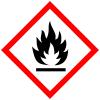pyrophoric
As pyrophoric ( Greek , of pyr 'fire' and phorein bear ', ie fire-supporting ) are chemical substances called that dispersed even at room temperature vigorously and in the air with oxygen react. The energy released during this oxidation is so high that the substances glow or even show the appearance of fire. The term can also be extended to other self-igniting substances and mixtures.
Types of pyrophores and physical explanation
Pyrophores are e.g. B. certain metal dusts that are reduced from their oxides (usually at low temperature) by means of hydrogen or are produced by other chemical reactions. These pyrophoric metals include B. magnesium , titanium , nickel , cobalt , iron , lead , the lanthanoids and the actinides , but also metal oxides in their lowest oxidation states ( called Oxydule ), such as. B. Manganese oxide and Uranium oxide . Lead dust is also pyrophoric and burns under the action of oxygen, as a result of which it is oxidized to lead (II, IV) oxide (Pb 3 O 4 , red lead ). Pyrophoric iron is u. a. generated by the careful decomposition of iron (II) oxalate taking place in the absence of air .
The most commonly used pyrophore is an alloy of approx. 70% rare earths ( cerium , lanthanum , yttrium etc.) and 30% iron . It is used as a flint in lighters . The pyrophoric effect is created by the dust-fine abrasion of this alloy, which is removed by the friction stone when turning.
Non-metals can also have pyrophoric properties, e.g. B. white phosphorus and certain sulfur compounds. White phosphorus ignites finely distributed in air. Pyrophoric sulfur liver is produced e.g. B. when sulphate- containing minerals ( alum , kieserite , potassium sulphate etc.) are heated with reducing substances such as sugar or flour in the absence of air.
The glowing of these preparations is due to their extremely fine distribution, with which they offer the oxygen a very large target area. If the metals mentioned are reduced at a higher temperature so that they become denser, they are no longer pyrophoric. The pyrophore made of alum was discovered by Wilhelm Homberg in 1711 (Homberg's phosphor), but it was only Carl Wilhelm Scheele in 1777 that gave the correct explanation for the glow.
Pyrophoric substances in weapons of war
- The pyrophoric effect of finely divided uranium is used as a side effect in the case of high-impact projectiles to set the target on fire. Uranium is also used as a liner ("sting" forming insert) in shaped charges and as shrapnel in anti- aircraft missiles.
- Tantalum is also used in armor-piercing warheads and has a strong fire-promoting effect due to the pyrophoric effect behind the penetrated armor.
- Zirconium is often used as a lining for warheads when an oxidizing effect is desired. Fire bomblets often contain zirconium because it burns at very high temperatures and can only be extinguished with sand, not water.
- In the case of titanium , metal fires in turbines are known. The Stinger guided weapon has a warhead with a titanium casing, which responds with a time delay so that the warhead only ignites within the hit target. The titanium then has a strong oxidizing effect there.
- The organometallic substance triethylaluminum (TEA) is used as a liquid fire agent or with thickeners such as polyisobutylene as a yellow fire agent ( English thickened pyrophoric agent , TPA ). Such incendiary agents can be regarded as the successor to the napalm and exceed this in terms of the burning temperature and incendiary effect, since after successful extinguishing, re-ignition usually sets in immediately and they react explosively with water.
Chemicals / Hazardous Substances Law
For the EU , Regulation (EC) No. 1272/2008 ( CLP Regulation ), which implements the Globally Harmonized System (GHS) of the UN , defines pyrophoric solids and liquids as those which, as a substance or mixture, have a tendency even in small quantities to ignite in contact with air within five minutes or, as a liquid, to ignite or char a filter paper in this time. They must be identified with the GHS pictogram, the signal word "Danger" and the hazard warning H250 (self-ignites in contact with air). Their placing on the market is restricted in aerosol dispensers.
Web links
- Pyrophores . In: Meyers Konversations-Lexikon . 4th edition. Volume 13, Verlag des Bibliographisches Institut, Leipzig / Vienna 1885–1892, p. 487.
- University of Oldenburg - pyrophoric properties of uranium
swell
- ↑ Entry on pyrophores. In: Römpp Online . Georg Thieme Verlag, accessed on June 13, 2014.
- ↑ Appendix I (Part 2: Physical hazards) No. 2.9 and 2.10 Regulation (EC) 1272/2008 . For self-heating substances and mixtures, no. 2.11.
- ↑ Art. 67 Annex XVII Entry 40 REACH Regulation
